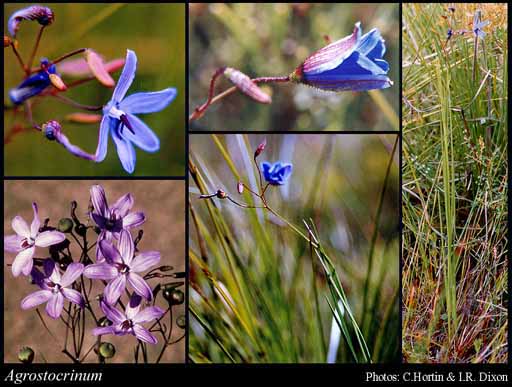- Reference
- Fragm. (Mueller) 2:94 (1861)
- Name Status
- Current







Scientific Description
Family Anthericaceae.
Sometimes included in Liliaceae.
Habit and leaf form. Herbs (tufted,the aerial stems erect or ascending, each associated with several grass-like leaves); evergreen, or deciduous. Perennial (leaves and stems annual). Leaves basal and cauline. Plants with a basal concentration of leaves, or with neither basal nor terminal concentrations of leaves; rhizomatous. Self supporting, or climbing. Mesophytic, or xerophytic. Leaves alternate; spiral, or distichous; ‘herbaceous’, or leathery, or membranous; sessile; sheathing. Leaf sheaths not tubular; with free margins. Leaves edgewise to the stem, or with ‘normal’ orientation; simple. Leaf blades entire; flat; linear, or lanceolate, or oblong, or ovate; parallel-veined; without cross-venules; sheathing but lacking a distinct sheath. Leaves ligulate, or eligulate; without stipules. Leaf blade margins entire (irregularly scabrous). Leaf anatomy. Hairs absent. Extra-floral nectaries absent. Stem anatomy. Secondary thickening absent.
Reproductive type, pollination. Fertile flowers hermaphrodite. Unisexual flowers absent. Plants hermaphrodite. Floral nectaries present. Nectar secretion from the gynoecium (from septal nectaries).
Inflorescence and flower features. Flowers aggregated in ‘inflorescences’; in racemes, or in corymbs, or in panicles. The terminal inflorescence unit cymose, or racemose (simple or compound). Inflorescences scapiflorous; terminal; inflorescence few to many-flowered, glandular bristles on upper axes; raceme simple or once-branched; with involucral bracts, or without involucral bracts; pseudanthial, or not pseudanthial. Flowers pedicellate (each subtended by a minute bract); bracteate (linear to subulate, inconspicuous); ebracteolate; small, or medium-sized; somewhat irregular; 3 merous; cyclic; pentacyclic, or tetracyclic. Perigone tube present (very short), or absent. Perianth with distinct calyx and corolla (the whorls rather different), or of ‘tepals’; 6; 2 -whorled (3+3); isomerous; free, or joined (with a basal tube); petaloid; similar in the two whorls, or different in the two whorls; white, or red, or yellow, or blue, or violet. Calyx (if the outer whorl so interpreted) 3; 1 -whorled; regular. Corolla (if the inner whorl so interpreted) 3; 1 -whorled; regular. Corolla members sometimes fringed, or . Androecial members definite in number. Androecium 6. Androecial members free of the perianth, or adnate (to the perianth); all equal; free of one another, or coherent; when joined, 1 - adelphous (basally connate); 1 -whorled, or 2 -whorled. Androecium exclusively of fertile stamens, or including staminodes. Staminodes when present, 3. Stamens 6; all more or less similar in shape; isomerous with the perianth, or diplostemonous; hypogynous; alterniperianthial, or oppositiperianthial. Anthers basifixed; dehiscing via pores, or dehiscing via longitudinal slits; introrse; tetrasporangiate; appendaged (short or partial tube at the base). Gynoecium 3 carpelled. The pistil 3 celled. Carpels isomerous with the perianth. Gynoecium syncarpous; synstylovarious, or eu-syncarpous; superior. Ovary plurilocular; 3 locular; sessile. Gynoecium stylate. Styles 1; from a depression at the top of the ovary; apical. Stigmas 1; 2–3 - lobed. Placentation axile. Ovules 2 per locule; arillate, or non-arillate; campylotropous (generally), or anatropous.
Fruit and seed features. Fruit non-fleshy; dehiscent; usually a capsule. Capsules loculicidal. Fruit 3 celled; 3–6 seeded. Seeds endospermic. Cotyledons 1. Embryo straight to curved.
Additional characters Pollen grains trichotomosulcate.
Taxonomic Literature
- Wheeler, Judy; Marchant, Neville; Lewington, Margaret; Graham, Lorraine 2002. Flora of the south west, Bunbury, Augusta, Denmark. Volume 1, introduction, keys, ferns to monocotyledons. Australian Biological Resources Study.. Canberra..